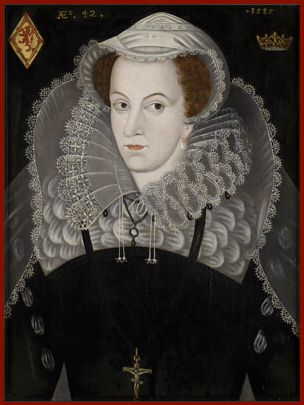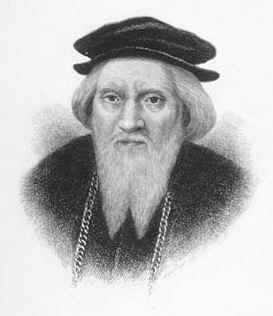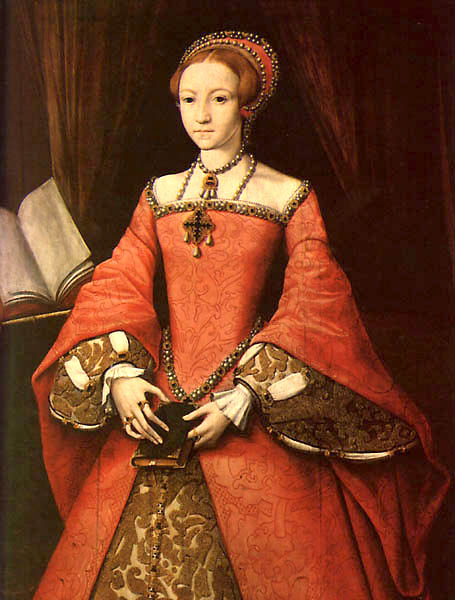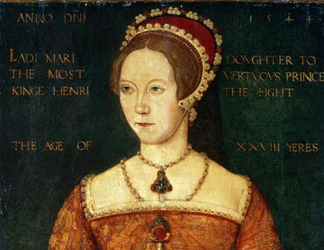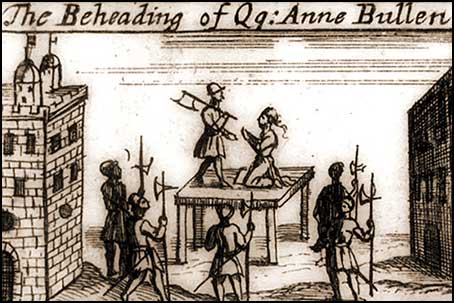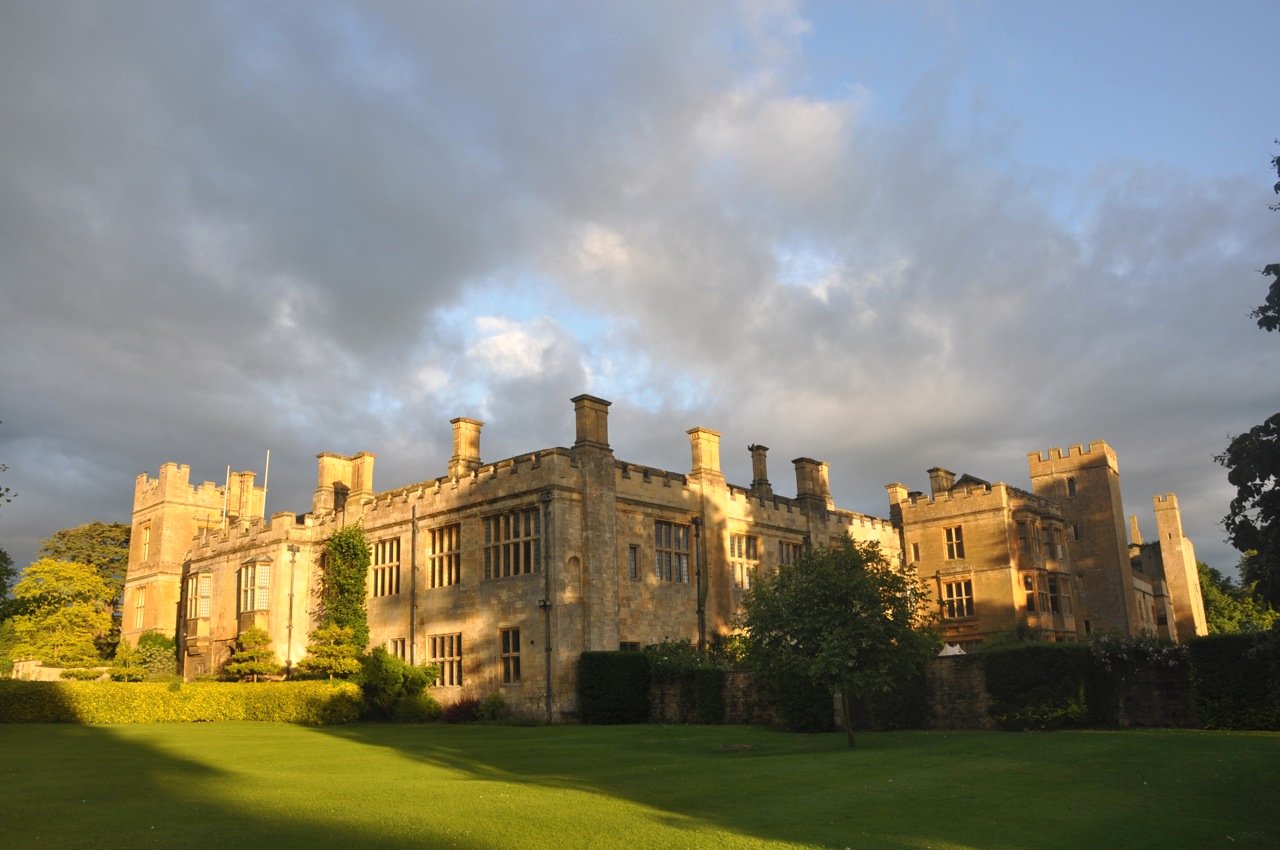Catherine
of Aragon (divorced)
Catherine
of Aragon was the youngest surviving child of Ferdinand and
Isabella, the joint rulers of Spain, and as was common for princesses
of the day, her parents almost immediately began looking for a
political match for her. When she was three year old, she was
betrothed to Arthur,
the son of Henry
VII of
England. Arthur was not even quite two at the time.
When
she was almost 16, in 1501, Catherine made the journey to England. It
took her three months, and her ships weathered several storms, but
she safely made landfall at Plymouth on October 2, 1501. Catherine
and Arthur were married on 14 November 1501 in Old St. Paul's
Cathedral, London. Catherine was escorted by the groom's younger
brother, Henry.
Henry
Tudor, named after his father, Henry
VII,
was born by Elizabeth
of York June
28, 1491 in Greenwich
Palace.
Since he was the second son, and not expected to become king, we know
little of his childhood. We know that Henry attended the wedding
celebrations of Arthur and his bride, Catherine
of Aragon,
in November 1501 when he was 10 years old.
After
the wedding and celebrations, the young couple moved to Ludlow Castle
on the Welsh border. Less than six months later, Arthur was dead,
possibly of the 'sweating
sickness'.
Although this marriage was short, it was very important in the
history of England, as will be apparent.
 |
| Ludlow Castle |
Catherine
was now a widow, and still young enough to be married again. Henry
VII still had a son, this one much more robust and healthy than his
dead older brother. The English king was interested in keeping
Catherine's dowry, so 14 months after her husband's death she was
betrothed to the future Henry VIII, who was too young to marry at the
time.
By
1505, when Henry was old enough to wed, Henry VII wasn't as keen on a
Spanish alliance, and young Henry was forced to repudiate (give up,
go against) the betrothal. Catherine's future was uncertain for the
next four years. When Henry VII died in 1509 one of the new young
king's first actions was to marry Catherine. She was finally crowned
Queen of England in a joint coronation ceremony with her husband
Henry VIII on June 24, 1509.
 |
| The coronation of Henry VIII and Catherine of Aragon |
Shortly
after their marriage, Catherine found herself pregnant. This first
child was a stillborn daughter born prematurely in January 1510, but
this disappointment was soon followed by another pregnancy. Prince
Henry was born on January 1, 1511 and the was christened on the 5th.
There were great celebrations for the birth of the young prince, but
they were halted by the baby's death after 52 days of life. Catherine
then had a miscarriage, followed by a another short-lived son. On
February 1516, she gave birth a daughter named Mary,
and this child lived. There were probably two more pregnancies, the
last recorded in 1518.
 |
| Henry VIII oldest surviving child, and unfortunately, a girl, Mary. |
Henry
was growing frustrated because he had no son and heir, but he
remained a devoted husband.
By 1526 though, he had begun to separate from Catherine because he
had fallen in love with one of her ladies: Anne
Boleyn.
It is
here that the lives of Henry's first and second wives begin to
interweave. By the time his interest in Anne became common knowledge,
Catherine was 42 years old and was no longer able to have more
children. Henry's main goal now was to get a male heir, which his
wife was not able to provide. Somewhere along the way Henry began to
look at the texts of Leviticus which say that if a man takes his
brother's wife, they shall be childless. As evidenced above,
Catherine and Henry were far from childless, and still had one living
child. But that child was a girl, and didn't count in Henry's mind.
The King began to petition (ask)the Pope for an annulment (a
divorce).
At
first, Catherine was kept in the dark about Henry's plans for their
annulment and when the news got to Catherine she was very upset. She
was also at a great disadvantage since the court that would decide
the case was far from impartial. Catherine then appealed directly to
the Pope, which she felt would listen to her case since her nephew
was Charles
V,
the Holy Roman Emperor.
The
political and legal debate continued for six years. Catherine was
adamant in that she and Arthur, her first husband and Henry's
brother, did not consummate their marriage and therefore were not
truly husband and wife. Catherine sought not only to retain her
position, but also that of her daughter Mary.
Things
came to a head in 1533 when Anne Boleyn became pregnant. Henry had to
act, and his solution was to reject the power of the Pope in England
and to have Thomas
Cranmer,
the Archbishop of Canterbury grant the annulment. Catherine was to
renounce the title of Queen and would be known as the Princess
Dowager of Wales, something she refused to acknowledge through to the
end of her life.
Catherine
and her daughter were separated and she was forced to leave court.
She lived for the next three years in several dank and unhealthy
castles and manors with just a few servants. However, she seldom
complained of her treatment and spent a great deal of time at prayer.
On
January 7, 1536, Catherine died at Kimbolton Castle and was buried at
Peterborough Abbey (later Peterborough Cathedral, after the
dissolution of the monasteries) with the ceremony due for her
position as Princess Dowager, not as a Queen of England.
Anne
Boleyn (beheaded)
Exactly
when and where Henry VIII first noticed Anne is not known. It is
likely that Henry sought to make Anne his mistress, as he had her
sister Mary years before. Maybe drawing on the example of Elizabeth
Woodville, Queen to Edward IV (and maternal grandmother to Henry
VIII) who was said to have told King Edward that she would only be
his wife, not his mistress, Anne denied Henry VIII sexual favors. We
don't know who first had the idea of marriage, but eventually it
evolved into "Queen or nothing" for Anne. No sex unless
they were married first!
At
first, the court probably thought that Anne would just end up as
another one of Henry's mistresses. But, in 1527 we see that Henry
began to seek an annulment of his marriage to Catherine, making him
free to marry again.
King
Henry's passion for Anne can be attested to in the love letters he
wrote to her when she was away from court. Henry hated writing
letters, and very few documents in his own hand survive. However, 17
love letters to Anne remain and are preserved in the Vatican library.
In
1528, Anne's emergence at Court began. Anne also showed real interest
in religious reform and may have introduced some of the 'new ideas'
to Henry, and gaining the hatred of some members of the Court. When
the court spent Christmas at Greenwich that year, Anne was lodged in
nice apartments near those of the King.
The
legal debates on the marriage of Henry and Catherine of Aragon
continued on. Anne was no doubt frustrated by the lack of progress.
Her famous temper and tongue showed themselves at times in famous
arguments between her and Henry for all the court to see. Anne feared
that Henry might go back to Catherine if the marriage could not be
annulled and Anne would have wasted time that she could have used to
make an advantageous marriage.
Anne
was not popular with the people of England.
In
this period, records show that Henry began to spend more and more on
Anne, buying her clothes, jewelry, and things for her amusement such
as playing cards and bows and arrows.
The
waiting continued and Anne's position continued to rise. On the first
day of September 1532, she was created Marquess of Pembroke, a title
she held in her own right. In October, she held a position of honor
at meetings between Henry and the French King in Calais.
Sometime
near the end of 1532, Anne finally gave way and by December she was
pregnant. To avoid any questions of the legitimacy of the child,
Henry was forced into action. Sometime near St. Paul's Day (January
25) 1533, Anne and Henry were secretly married. Although the King's
marriage to Catherine was not dissolved, in the King's mind it had
never existed in the first place, so he was free to marry whomever he
wanted. On May 23, the Archbishop of Canterbury officially proclaimed
that the marriage of Henry and Catherine was invalid.
Plans
for Anne's coronation began. In preparation, she had been brought by
water from Greenwich to the Tower of London dressed in cloth of gold.
The barges following her were said to stretch for four miles down the
Thames. On the 1st of June, she left the Tower in procession to
Westminster Abbey, where she became a crowned and anointed Queen in a
ceremony led by Thomas Cranmer, the Archbishop of Canterbury.
By
August, preparations were being made for the birth of Anne's child,
which was sure to be a boy. Names were being chosen, with Edward and
Henry the top choices. The proclamation of the child's birth had
already been written with 'prince' used to refer to the child.
Anne
took to her chamber, according to custom, on August 26, 1533 and on
September 7, at about 3:00 in the afternoon, the Princess Elizabeth
was born. Her christening service was scaled down, but still a
pleasant affair. The princess' white christening robes can currently
be seen on display at Sudeley Castle in England.
Anne
now knew that it was imperative that she produce a son. By January of
1534, she was pregnant again, but the child was either miscarried or
stillborn. In 1535, she became pregnant again but miscarried by the
end of January. The child was reported to have been a boy. The Queen
was quite upset, and blamed the miscarriage on her state of mind
after hearing that Henry had taken a fall in jousting. She had to
have known at this point that her failure to produce a living male
heir was a threat to her own life, especially since the King's fancy
for one of her ladies-in-waiting, Jane Seymour, began to grow.
Anne's
enemies at court began to plot against her using the King's
attentions to Jane Seymour as the catalyst for action. Cromwell began
to move in action to bring down the Queen. He persuaded the King to
sign a document calling for an investigation that would possibly
result in charges of treason.
On
April 30, 1536, Anne's musician and friend for several years, Mark
Smeaton, was arrested and probably tortured into making 'revelations'
about the Queen. Next, Sir Henry Norris was arrested and taken to the
Tower of London. Then the Queen's own brother, George Boleyn, Lord
Rochford was arrested.
On
May 2, the Queen herself was arrested at Greenwich and was informed
of the charges against her: adultery, incest and plotting to murder
the King. She was then taken to the Tower by barge along the same
path she had traveled to prepare for her coronation just three years
earlier. In fact, she was lodged in the same rooms she had held on
that occasion.
There
were several more arrests. Sir Francis Weston and William Brereton
were charged with adultery with the Queen. Sir Thomas Wyatt was also
arrested, but later released. They were put on trial with Smeaton and
Norris at Westminster Hall on May 12, 1536. The men were not allowed
to defend themselves, as was the case in charges of treason. They
were found guilty and received the required punishment: they were to
be hanged at Tyburn, cut down while still living and then
disemboweled and quartered. Ew!
On
Monday the 15th, the Queen and her brother were put on trial at the
Great Hall of the Tower of London. It is estimated that some 2000
people attended. Anne conducted herself in a calm and dignified
manner, denying all the charges against her. Her brother was tried
next, with his own wife testifying against him (she got her due later
in the scandal of Kathryn Howard). Even though the evidence against
them was scant, they were both found guilty, with the sentence being
read by their uncle, Thomas Howard , the Duke of Norfolk. They were
to be either burnt at the stake (which was the punishment for incest)
or beheaded, at the discretion of the King.
On
May 17, George Boleyn was executed on Tower Hill. The other four men
condemned with the Queen had their sentences commuted from the grisly
fate at Tyburn to a simple beheading at the Tower with Lord Rochford.
A beheading is much better than being disemboweled.
Anne
knew that her time would soon come and started to become hysterical,
her behavior swinging from great levity to body- wracking sobs. She
received news that an expert swordsman from Calais had been summoned,
who would no doubt deliver a cleaner blow with a sharp sword than the
traditional axe. It was then that she made the famous comment about
her 'little neck'.
Interestingly,
shortly before her execution on charges of adultery, the Queen's
marriage to the King was dissolved and declared invalid. One would
wonder then how she could have committed adultery if she had in fact
never been married to the King, but this was overlooked, as were so
many other lapses of logic in the charges against Anne.
They
came for Anne on the morning of May 19 to take her to the Tower
Green, where she was to be afforded the dignity of a private
execution. She made a short speech [read
the text of Anne's speech]
before kneeling on the scaffold. She removed her headdress (which was
an English gable hood and not her usual French hood, according to
contemporary reports) and her ladies tied a blindfold over her eyes.
The sword itself had been hidden under the straw. The swordsman cut
off her head with one swift stroke.
Anne's
body and head were put into an arrow chest and buried in an unmarked
grave in the Chapel of St. Peter ad Vincula which adjoined the Tower
Green. Her body was one that was identified in renovations of the
chapel under the reign of Queen Victoria, so Anne's final resting
place is now marked in the marble floor.
Jane
Seymour (died)
Jane
Seymour may have first come to court in the service of Queen
Catherine, but then was moved to wait on Anne Boleyn as she rose in
the King's favor and eventually became his second wife.
In
September 1535, the King stayed at the Seymour family home in
Wiltshire, England. It may have been there that the king "noticed"
Jane. But, it isn't until February of 1536 that there is evidence of
Henry's new love for Jane.
By
that point, Henry's disinterest in Anne was obvious and Jane was
likely pegged to be her replacement as Queen.
Opinion
is divided as to how Jane felt about being the new object of Henry's
affections. Some see Jane's calm and gentle demeanor as evidence that
she didn't really understand the position as political pawn she was
playing for her family. Others see it as a mask for her fear. Seeing
how Henry's two previous Queens had been treated once they fell from
favor, Jane probably had some trepidation, although Anne Boleyn's
final fate had not been sealed at that time.
One
other view was that Jane fell into her role quite willingly and
actively sought to entice the King and flaunt her favor even in front
of the current Queen.
However
Jane actually felt, we will never know. Henry's feelings were pretty
clear though. Within 24 hours of Anne Boleyn's execution, Jane
Seymour and Henry VIII were formally betrothed. On the 30th of May,
they were married. Unlike Henry's previous two Queens, Jane never had
a coronation. Perhaps the King was waiting forJane to 'prove' herself
by giving him a son.
It
wasn't until early 1537 that Jane became pregnant. During her
pregnancy, Jane's every whim was indulged by the King, convinced that
Jane, whom he felt to be his first 'true wife', carried his long
hoped for son. In October, a prince was born at Hampton Court Palace
and was christened on 15th of October. The baby was named Edward.
Mary, daughter of Catherine of Aragon, was godmother and Elizabeth,
daughter of Anne Boleyn, also played a role in the ceremony.
 |
| Finally! A son. |
There
has been much written over whether or not Jane gave birth to Edward
by cesarean section. It seems unlikely that if she had, she would
have lived as long as she did after the birth. Jane attended her
son's christening, although she was weak. She died on October 24th,
just two weeks after her son was born.
Henry
had already been preparing his own tomb at St. George's Chapel at
Windsor Castle, which was where Jane was buried. In the end, she
would be the only of Henry's six wives to be buried with him.
Anne
of Cleves (divorced)
 |
| Hans Holbein did a great job painting Anne. Because in real life, she was not this pretty. In fact, Henry VIII said she looked like a horse. |
Henry
VIII remained single for over two years after Jane Seymour's death,
possibly giving some credence to the thought that he genuinely
mourned for her. However, it does seem that someone, possibly Thomas
Cromwell, began making inquiries shortly after Jane's death about a
possible foreign bride for Henry.
Henry's
first marriage had been a foreign alliance of sorts, although it is
almost certain that the two were truly in love for some time. His
next two brides were love matches and Henry could have had little or
no monetary or political gain from them.
But
the events of the split from Rome left England isolated, and probably
vulnerable. It was these circumstances that led Henry and his
ministers to look at the possibility of a bride to secure an
alliance. Henry did also want to be sure he was getting a desirable
bride, so he had agents in foreign courts report to him on the
appearance and other qualities of various candidates. He also sent
painters to bring him images of these women.
Hans
Holbein, probably the most famous of the Tudor court painters, was
sent to the court of the Duke of Cleves, who had two sisters: Amelia
and Anne. When Holbein went in 1539, Cleves was seen as an important
potential ally in the event France and the Holy Roman Empire (who had
somewhat made a truce in their long history of conflict) decided to
move against the countries who had thrown off the Papal authority.
England then sought alliances with countries who had been supporting
the reformation of the church. Holbein painted the sisters of the
Duke of Cleves and Henry decided to have a contract drawn up for his
marriage to Anne.
Although
the King of France and the Emperor had gone back to their usual state
of animosity, Henry proceeded with the match. The marriage took place
on January 6, 1540. By then, Henry was already looking for ways to
get out of the marriage.
Anne
was ill-suited for life at the English court. Her upbringing in
Cleves had concentrated on domestic skills and not the music and
literature so popular at Henry's court. And, most famously, Henry did
not find his new bride the least bit attractive and is said to have
called her a 'Flanders Mare'. In addition to his personal feelings
for wanting to end the marriage, there were now political ones as
well. Tension between the Duke of Cleves and the Empire was
increasing towards war and Henry had no desire to become involved.
Last but not least, at some point, Henry had become attracted to
young Kathryn Howard.
Anne
was probably smart enough to know that she would only be making
trouble for herself if she raised any obstacles to Henry's attempts
to annul the marriage so the marriage was dissolved and Anne accepted
the honorary title as the 'King's Sister'. She was given property,
including Hever Castle, formerly the home of Anne Boleyn.
Anne
lived away from court quietly in the countryside until 1557 and
attended the coronation of her former step-daughter, Mary I.
She
is buried in a somewhat hard to find tomb in Westminster Abbey.
Kathryn
Howard (beheaded)
Kathryn
Howard was the daughter of Lord Edmund Howard, a younger brother of
Thomas Howard, Duke of Norfolk. She was also first cousin to Anne
Boleyn, Henry's ill-fated second Queen.
Kathryn
came to court at about the age of 19 as a lady in waiting to Anne of
Cleves and there is no doubt that the spirited young girl caught
Henry's attentions. Kathryn's uncle probably encouraged the girl to
respond to the King's attentions and saw it as a way to increase his
own influence over the monarch. The Duke of Norfolk also took
advantage of the debacle of the Anne of Cleves marriage as a chance
to discredit his enemy, Thomas Cromwell. In fact, Cromwell was
executed shortly after the marriage was nullified.
Sixteen
days after he was free of Anne, Henry took his fifth wife, Kathryn
Howard, on July 28, 1540. Henry was 49 and his bride was no older
than 19.
For
all that can be said against this match, Kathryn did manage to lift
the King's spirits. Henry had gained a lot of weight and was dealing
with the ulcerated leg that was to pain him until his death. The
vivacious young girl brought back some of Henry's zest for life. The
King lavished gifts on his young wife and called her his 'rose
without a thorn' and the 'very jewel of womanhood'.
Less
than a year into Kathryn's marriage, the rumors of her infidelity
began. In a way, one couldn't blame her for seeking the company of
handsome young men closer to her own age. But to do so, even if only
in courtly flirtations, was dangerous for a Queen, especially one who
came from a powerful family with many enemies. Kathryn didn't help
matters much by appointing one of her admirers as her personal
secretary.
By
November 1541, there was enough evidence against the Queen that
Archbishop Cranmer informed the King of Kathryn's misconduct. At
first Henry did not believe the accusations, but he agreed to allow
further investigations into the matter. Enough evidence was gathered
that the Queen had been promiscuous before her marriage and may have
had liaisons after becoming Henry's wife. She was executed on the
Tower Green on February 13, 1542 and laid to rest near her cousin
Anne Boleyn in the Chapel of St. Peter ad Vincula at the Tower of
London.

Katherine
Parr (survived)
Katherine
Parr was the eldest daughter of Sir Thomas Parr and his wife Maud
Green, both of whom were at the court of Henry
VIII in
his early reign. Maud was a lady-in-waiting to Queen Catherine
of Aragon and
named her daughter, born in 1512, after her. So, Henry VIII’s last
wife was named after his first.
Katherine
Parr’s first marriage was to Edward Borough, the son of Thomas,
third Baron Borough of Gainsborough in 1529 when she was 17 years
old. Edward died only a few years later, probably in early 1533. It
was during this marriage that Katherine’s mother Maud died, in
December 1531. Katherine’s second marriage was to John Neville,
third Baron Latimer of Snape Castle in Yorkshire, whom she married in
the summer of 1534 when he was 41 and she was 22. But he got sick
also and died in March 1543, leaving her a widow for the second time,
now at the age of 31. It was around this time that Katherine was
noticed by not only the King, but also Thomas
Seymour,
brother of the late Queen Jane
Seymour.
Katherine expressed her desire to marry Thomas Seymour after
Latimer’s death, but the King’s request for her hand was one that
Katherine felt it was her duty to accept. Katherine and Henry VIII
were married on July 12th in the Queen’s closet at Hampton
Court Palace in
a small ceremony attended by about 20 people.
Katherine
was interested in the reformed faith, making her enemies with the
conservatives of Henry’s court. It was Katherine’s influence with
the King and the Henry’s failing health that led to a plot against
her in 1546 by the conservative faction. Katherine and her ladies
were known to have had banned books which was grounds for arrest and
execution on charges of heresy. To gain evidence against the
Queen,Anne
Askew,
a well-known and active Protestant, was questioned and tortured, but
refused to recant her faith or give evidence against Katherine and
her ladies. However, there was enough other evidence against the
Queen to issue a warrant for her arrest. The warrant was accidentally
dropped and someone loyal to the Queen saw it and then quickly told
her about it. This is a well-documented incident that has made its
way into many historical fiction accounts. Sometimes the history
itself is the best drama! After learning of the arrest warrant,
Katherine was said to be very ill, either as a ruse to stall or from
a genuine panic attack. Henry went to see her and chastised her for
her outspokenness about the reformed religion and his feeling that
she was forgetting her place by instructing him on such matters.
Katherine’s response in her defense was that she was only arguing
with him on these issues so she could be instructed by him, and to
take his mind off other troubles. Playing to Henry’s ego no doubt
helped and Katherine was forgiven.
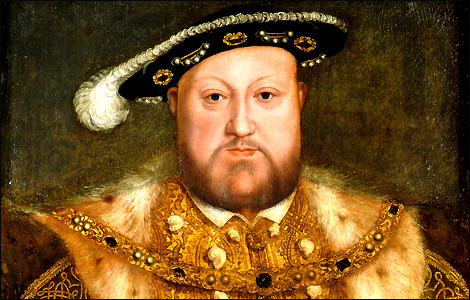
Katherine
was close with all three of her stepchildren as Henry’s wife and
was personally involved in the educational program of the younger
two, Elizabeth and Edward.
She was also a patron of the arts and music. Katherine’s own
learning and academic achievements, as alluded to previously, were
impressive, and in 1545, her book “Prayers or Meditations” became
the first work published by an English Queen under her own name.
Another book, “The Lamentation of a Sinner”, was published after
Henry VIII’s death.
Henry
VIII died in January 1547 and Katherine had probably expected to play
some role in the regency for the new nine-year-old king, Edward VI,
but this was not to be. Only a few months after Henry’s death,
Katherine secretly married Thomas Seymour, but the quickness and
secret nature of the union caused a scandal. Katherine was still able
to take guardianship of Princess Elizabeth and Seymour purchased the
wardship of the king’s cousin, Lady
Jane Grey.
After
three previous marriages and at the age of 36, Katherine was pregnant
for the first time and in June 1548, she moved to Sudeley
Castle in
Gloucestershire to await the birth of her child. On August 30th she
gave birth to a daughter named Mary. Katherine soon fell ill with
puerperal fever, which was to claim her life in the morning hours of
September 5th. Katherine was buried, with Lady Jane Grey as the chief
mourner, in the chapel at Sudeley Castle, where the tomb can still be
visited today.
**This information was found at ... http://tudorhistory.org/wives/
